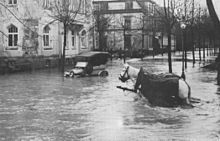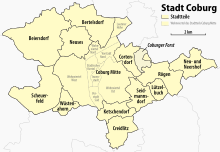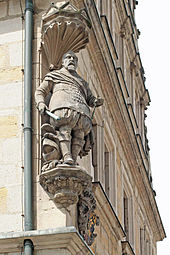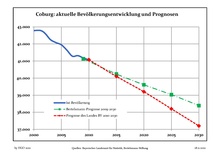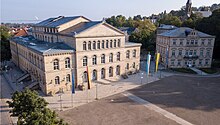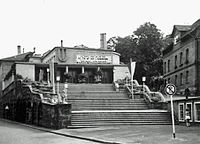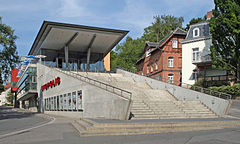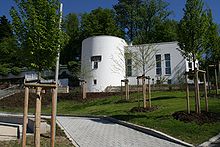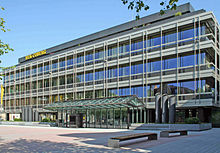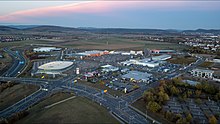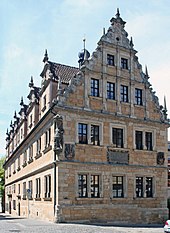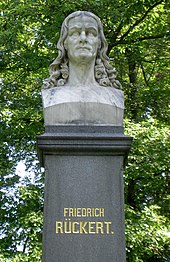Coburg
| coat of arms | Germany map | |
|---|---|---|

|
Coordinates: 50 ° 16 ' N , 10 ° 58' E |
|
| Basic data | ||
| State : | Bavaria | |
| Administrative region : | Upper Franconia | |
| Height : | 292 m above sea level NHN | |
| Area : | 48.29 km 2 | |
| Residents: | 41,072 (Dec. 31, 2019) | |
| Population density : | 851 inhabitants per km 2 | |
| Postal code : | 96450 | |
| Area code : | 09561 | |
| License plate : | CO, NEC | |
| Community key : | 09 4 63 000 | |
| NUTS : | DE243 | |
| City structure: | 12 districts | |
City administration address : |
Markt 1 96450 Coburg |
|
| Website : | ||
| Lord Mayor : | Dominik Sauerteig ( SPD ) | |
| Location of the city of Coburg in Bavaria | ||

Coburg is an independent city in the Bavarian administrative district of Upper Franconia and the seat of the Coburg district office . It belongs to the metropolitan region of Nuremberg . From 16./17. From the 19th century until 1918 it was the residence of the Dukes of Saxe-Coburg , and from the middle of the 19th to the end of the 20th century it was a garrison town . Coburg has been the location of a technical college since 1971 . Through incorporations in 1934 and from 1972 to 1977, the city area expanded to four times its size. Coburg has been nicknamed European City since 2005 . One of the largest castle complexes in Germany rises above the city with the Veste Coburg .
geography
Location and overview
Coburg is located between the southern foothills of the Thuringian Forest , the Langen mountains and the Main valley and is supported by the Itz traversed, in the within the urban area in the Heiligkreuzkirche the Lauter opens. This unites with the Sulz in the Neuses district and is still fed by the Rottenbach in Coburg . The Hahn River coming from Cortendorf , a 1967 piped Mühlbach of the Itz, flows into the Itz at the edge of the city center at the Judenbrücke .
20 bridges span the Itz in the city area. With the catchment area of the Itz above Coburg of about 346 km², there were frequent major floods in the city until the construction of the flood retention basin Froschgrundsee in 1986, especially in the lower station district, the former floodplain of the Itz. The last time the Itz broke its banks in 2003 in Coburg. To prevent such events, the Goldbergsee flood retention basin was dammed for Sulz and Lauter in 2010 .
The nearest large cities are Erfurt , about 80 km north as the crow flies, Würzburg , about 90 km southwest, and Erlangen and Nuremberg , about 75 and 90 km south, respectively. The height of the market square is 296 m above sea level. NN , the fortress 451 m above sea level. NN .
City structure
Coburg consists of the core city and twelve other districts .
| district | Area km² |
Inhabitants 2002 |
Density PE / km² |
Resident January 1, 2011 |
|---|---|---|---|---|
| Coburg Mitte (core city) | 13.91 | 27,120 | 1,950 | 25,841 |
| Beiersdorf (with Callenberg) | 7.3 | 1,421 | 194 | 1,487 |
| Bertelsdorf (with Glend ) | 4.00 | 1,407 | 352 | 1,601 |
| Cortendorf | 1.65 | 1,349 | 818 | 1,500 |
| Creidlitz (with Hambach ) | 2.30 | 1,732 | 753 | 1,707 |
| Ketch Village | 1.79 | 1,517 | 847 | 1,635 |
| Lützelbuch | 1.00 | 458 | 458 | 420 |
| New and Neershof (with Neuhof and Neershof ) | 2.51 | 232 | 92 | 254 |
| News | 2.74 | 1,720 | 628 | 1,644 |
| Rögen | 3.05 | 384 | 126 | 368 |
| Scheuerfeld (with Dörfles and Eichhof ) | 4.83 | 2,425 | 502 | 2,291 |
| Seidmannsdorf (with Löbelstein ) | 1.98 | 682 | 344 | 667 |
| Desert maple | 1.23 | 2.002 | 1,628 | 1,705 |
| City of Coburg | 48.29 | 42,449 | 878 | 41,120 |
Two thirds of the population live in the central city in the Itztal. In particular, the outer districts of Rögen as well as Neuhof and Neershof still have a strong village character.
Neighboring communities
The following municipalities in the district of Coburg border the city of Coburg in a clockwise direction, starting in the north: Lautertal , Dörfles-Esbach , Rödental , Ebersdorf bei Coburg , Grub am Forst , Niederfüllbach , Untersiemau , Ahorn , Weitramsdorf and Meeder .
climate
Coburg's climate is characterized by its location between the upper Main Valley in the south and the Thuringian Forest in the north. It is also influenced by the valley location. The summers are relatively warm, but mild winters prevent the proximity to the Thuringian Forest.
The annual mean temperature is around 8.9 ° C, the mean daytime temperature is −1.4 ° C in January and 17.2 ° C in July. On average there are five hot days, 36 summer days and 28 ice days per year . Every year there is an average of 747 mm of precipitation, distributed relatively evenly over the months. There are maxima in June with 82 mm and in December with 73 mm. There is an average of more than 1.0 mm of precipitation every third day.
|
Average monthly temperatures and precipitation for Coburg
Source: wetterkontor.de
|
|||||||||||||||||||||||||||||||||||||||||||||||||||||||||||||||||||||||||||||||||||||||||||||||||||||||||||||||||||||||||||||||||||||||||||||||||||||||||||||||||||||
history
11th to 18th centuries
Coburg was first mentioned in a document in 1056 in a deed of gift from the Polish Queen Richeza to the Archbishop Anno of Cologne about the country around Coburg. In 1331, Emperor Ludwig granted Coburg town charter and the right to its own jurisdiction. 22 years later, in 1353, Margrave Friedrich III inherited . von Meißen and thus the House of Wettin from the Henneberg Count Heinrich ruled Coburg ( care Coburg ). While the Hussites plundered areas of the Coburg country in 1430, the city of Coburg was not attacked. Saint Mauritius appeared in the city arms in 1430 .
In 1485, after the division of Leipzig , Coburg belonged to the Ernestines . Since the Saxon electors supported the Reformation , it could be introduced in Coburg by 1524. In 1530, Martin Luther stayed at the Veste Coburg for six months because he was unable to attend the Reichstag in Augsburg because of the eight imposed on him .
Between 1586 and 1633 Coburg was the first residence and capital of the independent duchy of Saxony-Coburg . During this time, some Renaissance buildings were built in Coburg under Duke Johann Casimir , which still shape the cityscape. After a period from 1680 to 1699 under Duke Albrecht , Coburg was again the royal seat in 1735, this time the Dukes of Saxe-Coburg-Saalfeld and from 1826 of Saxe-Coburg and Gotha .
From 1532 there were individual witch trials in Coburg . During the reign of Duke Johann Casimir (1586–1633), around 178 witch trials can be identified, with intense persecutions from 1612 to 1619 and from 1628 to 1632. In total, there were at least 228 witch trials in Coburg and the surrounding area in the 16th and 17th centuries.
19th to 20th century
At the beginning of the 19th century, the Residenzschloss Ehrenburg was redesigned under Duke Ernst I. The palace square received its present appearance with the new court theater, the arcades and the enlarged court garden.
The year 1858 with the first railway connection to the Werra Railway was important for urban development . Among other things, the railway connection meant that in the following 60 years emperors, tsars, kings and princes often came to visit their relatives in Coburg. Under the reign and patronage of the liberal Duke Ernst II , the city became the center of the German national movement organized in associations around 1860.
The monarchy ended on November 14, 1918 with the resignation of Duke Carl Eduard . On November 30, 1919, in one of the first democratic referendums in Germany in the city of Coburg, 9,402 votes voted against the merger of the Free State of Coburg with the State of Thuringia and 1,624 votes in favor. Thus Coburg came to the Free State of Bavaria on July 1, 1920 .
From 1922 Coburg developed into a stronghold of National Socialism.
As early as 1929, the NSDAP received an absolute majority of the seats in a German city in the city council elections for the first time . Coburg gave 1932 as the first German city to Adolf Hitler the honorary citizenship . From 1939 Coburg was allowed to use the honorary title of “Germany's First National Socialist City”.
In 1925 Coburg had 316 Jewish residents. With a total population of 25,707 there were still 233 Jewish citizens in 1933. The memorial book of the Federal Archives for the victims of the National Socialist persecution of Jews in Germany lists 64 Jewish residents of Coburg, who were deported and mostly murdered .
During the Second World War , Coburg was 4.1% destroyed by air raids and artillery fire, a total of 402 apartments were completely destroyed and 639 damaged. The city was occupied by the 11th US Armored Division on April 11, 1945. The referendum of 1919 with the connection to Bavaria now had unexpected consequences. Coburg became part of the American zone of occupation , while the Thuringian hinterland belonged to the Soviet zone of occupation and remained cut off from Coburg until 1989 by the zone border and from 1949 on the inner-German border. Coburg was therefore on the edge of the zone .
In 1950, the liability support fund moved to motor vehicle officials in Germany a. G., Erfurt, today's insurance group HUK-Coburg , is based in Coburg. With around 5,500 employees working on site (as of 2015), it is the largest employer and trade tax payer in Coburg, which results in the highest trade tax income in relation to the number of inhabitants in Bavaria and the fifth highest in Germany.
In the 21st century
Coburg's importance for the region has increased, especially due to the reunification of Germany . The city is the regional center with important infrastructure, such as the state theater, state library, clinic and many different schools, including four high schools. Coburg has been nicknamed European City since May 30, 2005 . This epithet is used to describe cities that are particularly committed to the idea of European understanding. In 2014, Coburg was awarded the honorary title of “ Reformation City of Europe ” by the Community of Evangelical Churches in Europe .
Incorporations
On July 1, 1934, Ketschendorf, Wüstenahorn, Cortendorf (with the associated forest district of Coburg I Bausenberg) and Neuses near Coburg were incorporated, making Coburg a garrison location again (a population of 30,000 was required for this). At the end of the 1930s, the approximately 20 hectare site of the Hindenburg barracks was assigned to Dörfleser Flur. The 1970s were characterized by a larger number of incorporations as part of the municipal area reform . At the beginning of 1972 it was Lützelbuch, Rögen and Seidmannsdorf (with Löbelstein), and on July 1st, Beiersdorf near Coburg (known for the Callenberg Castle ), Creidlitz and Scheuerfeld. On July 1, 1976, the former community Neu- und Neershof and the Gut Neudörfles from the community Dörfles-Esbach were added, as well as on January 1, 1977 Bertelsdorf and Glend, which was incorporated there in 1868. In 1993 Coburg von Lautertal acquired 105 hectares for a new building area. The area of the city has thus more than quadrupled since 1900 from 11.4 to over 48 square kilometers.
Notation
Outside of Coburg, the spelling Koburg was also used. A presidential decree of the government of Upper Franconia on October 30, 1920 specified the spelling of the name of the city of Coburg .
religion
Historical overview
The Coburg area belonged to the diocese of Würzburg since the Christianization of Franconia and Thuringia, probably for the first time around 768 until the introduction of the Reformation in 1524 . After that, the city was almost exclusively a Protestant city for four centuries. The Lutheran creed was predominant . In 1910 over 96 percent of the population were members of the Protestant regional church. Head of the regional church was the respective Duke of Saxe-Coburg as " summus episcopus ". Among other things, he appointed the church governments. The spiritual direction was held by the superintendent based in Coburg. After the unification of Coburg with Bavaria, the Evangelical Church of Coburg joined the Evangelical Lutheran Church of Bavaria in 1921 . Coburg is the seat of a deanery which, with over 76,129 members (2008), is one of the largest in Bavaria.
Roman Catholic parishioners moved back to the city no later than the 18th century. From 1802 they were allowed to hold church services, first in a room at Ketschengasse 1 , from 1806 in the Nikolaus Chapel. In 1860, under the protection of Prince August von Sachsen-Coburg-Koháry , the approximately 600 Catholics received the new St. Augustin church as their own church. In 1826 the parish was incorporated from the diocese of Würzburg into the archbishopric of Bamberg .
In addition to the two large churches, there are also congregations today that belong to free churches , including the Evangelical Free Church Congregation ( Baptists ), the Adventist church ( Seventh-day Adventists ) and the Christian Community . There is also a New Apostolic congregation, an old Catholic parish in the St. Nicholas Chapel , the Church of Jesus Christ of Latter-day Saints and Jehovah's Witnesses in Coburg. The villa Judaeorum (Jewish suburb) was first noted as early as 1321 . There has been no Jewish community with a synagogue since 1941. In 2006 there were three houses of prayer of Muslim communities in Coburg .
Denomination statistics
According to the 2011 census , 53.3% of the population were Protestant , 19.8% Roman Catholic ; 26.9% belonged to another or no religious society under public law , or no information was available on a religious society under public law. At the end of 2019, 17,638 (42.8%) of the 41,206 inhabitants were Protestant, 7,288 (17.7%) were Roman Catholic and 16,280 (39.5%) were others.
Population development
In 1480 there were 2,000 inhabitants in the city. Only in the course of the 19th century did the population increase more rapidly and in 1843 it reached 10,000. From 1864 to 1875 the city grew by almost 4,000 inhabitants to 14,570, which corresponds to a growth of 37 percent. At the beginning of 1900 the number of citizens was 20,460. Despite a decrease in the number of inhabitants of around 10 percent after the First World War , over 25,000 people lived in the city in 1927. The first incorporations in 1934 resulted in a jump of about 10 percent to 29,000 inhabitants; the peak was reached in 1946 with 50,000 inhabitants, of which around 15,000 were refugees. Since the end of the 20th century (42,800) the population has steadily decreased slightly. In 2009 the number of inhabitants rose slightly for the first time since 1990 and amounted to 41,450. At the end of 2018, the city had 41,249 inhabitants.
2,634 foreigners 6.4% of the total population, lived in the city in 2008. As of December 31, 2019, 4,780 of a total of 41,206 residents were foreigners, i.e. H. 11.5%.
For the population development up to 2020 (starting point 2008) with increasing migration losses as the lower value a population of 37,500 and assuming a balanced migration balance and increasing birth rate as the upper value a population of 40,000.
politics
City council
The city council of Coburg consists of the mayor and the number of 40 city council members required by the municipal code. The Lord Mayor is elected directly and like the city council for a period of six years.
After the local elections on March 2, 2008 , the SPD provided 16 city councilors, the CSU was represented by 9 city councilors since a city council resigned from the parliamentary group on February 17, 2009. On April 13, 2007, seven city councilors of the CSU parliamentary group announced that they would be leaving due to insurmountable differences within the group and that they would found their own parliamentary group. After the 2008 election, the new voter association Christian-Social Citizens provided four city councilors. Bündnis 90 / Die Grünen were represented by three city councils and the Free Voting Association Coburg and the FDP with two mandates each. The ÖDP and the new groups JUnge COburger (supported by the Junge Union Coburg-Stadt) and Citizens Moving Coburg each provided a city council . In September 2009, the Free Voting Community named itself Pro Coburg e. V. around.
After the local elections on March 16, 2014 , the SPD 14, the CSU 10, Bündnis 90 / Die Grünen and the Christian-Social Citizens of Coburg each provided 4, the electoral community Pro Coburg 3 and JUnge COburger 2 city councilors, the FDP, DIE LINKE and the ÖDP 1 city council each. On February 13, 2015, three city councilors of the SPD announced that they would resign from their parliamentary group and join forces with the city council of the Left to form a new parliamentary group “Social and Citizens for Coburg”. On March 6, 2015, it was announced that the two city councilors of the Young Coburgs were joining the CSU parliamentary group, which now had twelve members and was thus the strongest parliamentary group in the city council. The distribution of seats was now CSU / JUCO: 12, SPD: 11, Bündnis 90 / Die Grünen: 4, CSB: 4, SBC: 4, WPC: 3, FDP: 1, ÖDP: 1.
The local elections on March 15, 2020 led to the result shown on the right and from this to the following distribution of seats in the Coburg City Council:
| Party / list | Seats |
| Social Democratic Party of Germany (SPD) | 9 seats |
| Christian Social Union in Bavaria (CSU) | 8 seats |
| Alliance 90 / The Greens (Greens) | 6 seats |
| Pro Coburg Voting Association (WPC) | 5 seats |
| YOUNG COburger e. V. (JUCO) | 3 seats |
| Christian-Social Citizens (CSB) | 3 seats |
| Free Democratic Party (FDP) | 2 seats |
| Alternative for Germany (AfD) | 1 seat |
| The left | 1 seat |
| Ecological Democratic Party (ÖDP) | 1 seat |
| Coburg List (CL) | 1 seat |
First Mayor, Lord Mayor
- 1846–1865: Leopold Oberländer
- 1865–1896: Rudolf Muther
- 1897–1924: Gustav Hirschfeld
- 1924–1931: Erich Unverfähr , non-party
- 1931–1934: Franz Schwede , NSDAP
- 1934–1937: Otto Schmidt , NSDAP
- 1937–1938: Wilhelm Rehlein , NSDAP
- 1938–1945: August Greim , NSDAP
- 1945, provisional: Alfred Sauerteig
- 1945, acting: Eugen Bornhauser
- 1945–1948: Ludwig Meyer , SPD
- 1948–1970: Walter Langer , FDP
- 1970–1978: Wolfgang Stammberger , SPD
- 1978–1990: Karl-Heinz Höhn , independent (supported by the CSU)
- 1990-2014: Norbert Kastner , SPD (1990, when 30 years old, youngest mayor in Germany)
- 2014–2020: Norbert Tessmer , SPD
- since 2020: Dominik Sauerteig , SPD
Seal, coat of arms, motto
| Blazon : "In gold, a black Moor's head with a gold earring ." | |
|
Justification for the coat of arms: Seal impressions from 1272 represented a tinned wall with a tower , a house and the Henneberger hen. After the Wettins took over the city in 1353, the Meissner and Thuringian lion appear twice on a four-quartered shield .
Today's coat of arms represents the city's patron saint , Saint Mauritius , who, according to Christian tradition, has been venerated in the appearance of a black African since the High Middle Ages at the latest. Mauritius is considered the leader of the Thebaic Legion and fighter for the Christian faith, which is said to have carried the Holy Lance with him. His image is on Coburg coins and a silver punch of the 14th / 15th centuries. Century, since the 16th century with the still valid colors on documents. During the Nazi era in 1934 the historical coat of arms was exchanged for a sword with a swastika in the pommel on a shield split in black and gold . Since the announcement on May 1, 1945 and the approval of the provisional city committee on August 6, 1945, the city coat of arms again shows St. Mauritius (heraldically referred to as Mohren ), initially in different designs, from 1974 in its current form. |
Coburg has had the motto "Values and Change" since the 1990s.
Town twinning
Coburg has six active partnerships with locations in Western Europe and North America:
- In 1951, Garden City in the state of New York became the first twin city after it had taken the initiative for reasons of international understanding. The city partnership was terminated on March 31, 2017, as no contact was made with representatives of the city and the partnership association for a period of one and a half years.
- The second partnership was established in 1972 with Oudenaarde in Belgium .
- The first attempts at partnership with the city of Niort in France in 1971 were initially in vain, but three years later they were successful.
- In 1977 Gais in South Tyrol , which had had a sponsorship with the later district of Lützelbuch since 1971, became a partner municipality of Coburg after its incorporation.
- The Isle of Wight ( United Kingdom ) followed in 1983 as the fifth partnership.
- The sixth partnership was entered into in 1997 with the Canadian namesake Cobourg , after Coburg had made the first proposals in 1972.
- In 2019, Coburg signed another city partnership with the US city of Toledo .
Culture and sights
Theaters and cinemas
The building of the Coburg State Theater was built in the 1840s by Duke Ernst II as a court theater. An almost identical theater was built in Gotha at the same time (destroyed in World War II). The State Theater is located in the building ensemble on Schlossplatz. The multi-part classical building contains, among other things, a hall of mirrors and an auditorium. Due to the co-financing (40%) by the Free State of Bavaria , it can also be called the third Bavarian state theater . It is a three-branch theater (opera / operetta, drama, ballet) and has 550 seats in the large house and 99 seats in the former riding hall . The cultural venue Globe is to be built from 2020 to 2022 as a replacement venue for the multi-year period of renovation and renovation measures .
Between 1920 and 1975 the city had up to seven movie theaters ( Union Theater , Atelier im UT (opening on May 2, 1974), Central Lichtspiele , Passage Lichtspiele under the direction of Werner Gutmann, Burgtheater , Casino , Kali under the direction of the family Heublein). Today there is the Utopolis multiplex cinema with nine halls. In 2001 it replaced the former Union Theater , which had opened in 1919 in the hall of the former club brewery. The Art Nouveau building erected in 1900 was rebuilt in the early 1930s and expanded to accommodate 600 people. One of the conditions for the new construction of the cinema center was to keep the spacious open staircase.
Local media
Coburg has two daily newspapers, the Coburger Tageblatt , founded in 1886, a regional edition of the Fränkischer Tag newspaper from Bamberg since 2003 , and the Neue Presse , founded in 1946 , of which the majority has belonged to the Süddeutscher Verlag media group since 1986 . The two local radio stations are Radio 1 and Radio Galaxy Coburg . The latter is a local station on the youth-oriented radio Galaxy . The local internet TV broadcaster ITV-Coburg puts contributions on the net almost daily.
Buildings
overview
Coburg has a well-preserved old town, which is limited by parts of the city wall that still exist with Jewish, Ketch and hospital gates. The city is rich in buildings worth seeing, fountains , memorials and historical ensembles, ground monuments , land monuments and garden monuments. Representative villas stand among other things on the adjacent mountain slopes.
Veste Coburg
The Veste Coburg rises 170 meters above the city and is one of the largest and best preserved castle complexes in Germany . It was first mentioned in a document in 1225, expanded into a state fortress with a triple wall ring in the 17th century and houses the former ducal art collections.
Palace Square and Ehrenburg Palace

At the foot of the mountain fortress of lies Castle Square , in the center a monument of Duke Ernst I. stands. The square was designed from 1830 to 1837. It is bordered by the former royal palace Ehrenburg , the arcades with the court garden, the Palais Edinburgh and the State Theater . The foundation stone of Ehrenburg Castle was laid in 1543 by Duke Johann Ernst of Saxony, and from 1623 to 1627 Duke Johann Casimir expanded the residence into a Renaissance palace. The baroque castle church, completed in 1701, is located in the west wing. In the 19th century, Duke Ernst I had the castle given a facade in the style of English neo-Gothic . The Ehrenburg houses the Coburg State Library and is a museum .
Town hall and town house
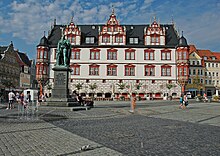
In the vicinity of Schlossplatz is the market square , framed by the town hall and town house . In its center is the Prince Albert Memorial, a gift from Queen Victoria to the hometown of her deceased husband. Queen Victoria attended the solemn unveiling of the monument on August 26, 1865 during her fifth visit to Coburg. Between 2004 and 2005, the square was redesigned with greenery, new lighting and water fountains around the Prince Albert monument. The new town hall with the two-storey Coburg bay and a 27-meter-long and 13-meter-wide council chamber was built by the master builder Hans Schlachter from 1577, and major renovations were carried out in 1750 and 1903. Duke Johann Casimir had the town house on the opposite side built as a ducal Cantzley in 1601 . It is a late Renaissance building with an ornate facade and multi-colored wall paintings. The court pharmacy from the 15th century is a late Gothic stone building with a small choir and a Madonna and Child on a corner of the facade as well as a Christophorus sculpture on Steingasse.
Churches
The Morizkirche in the city center is the oldest church in Coburg. It was built from 1320 to 1586 and is the main church of the Protestant town. The oldest part of the church, the east choir, dates from 1330. The west portal with the two unequal towers was built around 1420. About a hundred years later, the nave was erected again. In the Easter week of 1530, Martin Luther preached in the church.
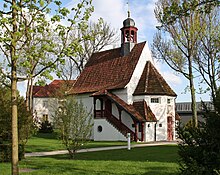
The Catholic parish church of St. Augustin stands behind the state theater. It is a neo-Gothic church with a princely crypt that was built between 1855 and 1860 according to designs by Vincenz Fischer-Birnbaum.
The Salvatorkirche is not far from the Morizkirche and is somewhat hidden on the lower complex. It is the Evangelical Lutheran cemetery church of the Salvator cemetery, which was laid out in 1494. The church, a hall with a choir closed on three sides, was built between 1660 and 1662.
The St. Nikolaus Chapel , located on the southern edge of the old town, was built in 1442 as an infirmary chapel for lepers and is owned by the town. From 1529 it was the chapel of the Protestant, from 1806 the Catholic community and from 1873 to 1932 the synagogue . At the end of 1932 the city terminated the right of use to the Jewish community. From 1945 it was the church of the free church and since 1962 it has been the chapel of the old Catholic community. To the north of the former city gates, on the Itz, is the Holy Cross Church . The choir of the Evangelical Lutheran parish church was built in the Gothic style in the years 1401 to 1407, the nave from 1413. In the years 1735 to 1739 the church was redesigned into a hall church with a baroque interior. The stucco ceiling and the organ front also date from this period.
More buildings in the city center
The Casimirianum grammar school stands next to the Morizkirche ; the Renaissance building was inaugurated in 1605. The armory in Herrngasse between Schlossplatz and Marktplatz also dates from this period; it was built in 1621 as an arsenal. It was later expanded in the style of the late Renaissance and performed changing tasks. Today it serves as the state archive.
Listed half-timbered buildings are the Hahnmühle from 1323 and the Münzmeisterhaus . The latter was the former court of the mint master, called von Rosenau, who were mentioned in a document in 1288. It has existed since 1444 and is one of the most important town houses in the city.
Castles
Due to its long history as a residential city, Coburg has a large number of smaller castles in addition to Ehrenburg Castle.
In the vicinity of the State Theater is the Bürglaß-Schlösschen . It once belonged to Friedrich Josias of Saxe-Coburg-Saalfeld and later served as a second residence for Tsar Ferdinand of Bulgaria after his abdication; today the Coburg registry office is located there . To the north-east of this stands the Rosenauschlösschen , a half-timbered building with parts from 1435 on Rittersteich . Hohenfels Castle has risen on the Ernsthöhe above Callenberger Strasse since 1840 . It was built at the same time and in the same style as the State Theater by its builder.
There are other castles in the incorporated suburbs:
In the Ketschendorf district, in the midst of an extensive park, is the neo-Gothic Ketschendorf Castle of the Baroness von Stolzenau from the beginning of the 19th century. From 1956 to 2010 it was the Coburg Youth Hostel .
Falkenegg Castle above the Neuses district is one of the romantic buildings of historicism from the early 19th century. Falkenegg also has a small mountain park with an obelisk in memory of Moritz August von Thümmel .
Callenberg Castle in the Beiersdorf district was first mentioned in a document in 1122 and was the summer residence of the Coburg dukes from 1825. The three-wing palace complex is an example of neo-Gothic in Bavaria. Since 1998 the castle has housed the private collection of the ducal art collection, and the German Rifle Museum has been built there since 2004.
Neuhof Castle from the 14th century is located in Neuhof and Neershof, the easternmost part of Coburg. Field Marshal Count Albrecht von Roon was the prominent owner of the castle, which is surrounded by an English landscape park , from 1873 to 1879 .
Eichhof Castle in the Dörfles district of the Scheuerfeld district, first mentioned in a document in 1440, belonged to the Coburg family until 1979 and is still managed as an estate .
Neudörfles in Neustadter Straße also dates from the 15th century and is a listed ensemble with a manor house and the second largest private park in the city.
Neo-Gothic development ring
During the reign of Duke Johann Casimir and his house architect Peter Sengelaub, the Coburg townscape was shaped by Renaissance monuments, such as the former government building, now the town hall, the armory and the Casimirianum high school, so it was in the first new building epoch of the 19th century Master builders such as Julius Martinet, as a homage to the British royal family, which at that time was still called Saxe-Coburg and Gotha , adopted an architectural style that was revolutionary for the time and can be attributed to Wilhelminian style historicism, namely neo-Gothic .
The Greek affix neo indicates that this - in the course of the Gothic Revival , which began in England in the 18th century - is a new edition of a style that imitates Gothic (features include pointed arches, pinnacles ). This architectural style was used in Coburg in a rare urban design quality. After its neo-Gothic facade design by Karl Friedrich Schinkel, the Ehrenburg reveals its architectural relationship with the world's most famous neo-Gothic monument, the Palace of Westminster in London.
The neo-Gothic development ring created in Coburg is considered an urban jewel that went down in building history as a Coburg special development and is apostrophized in architectural circles as "unique on the European continent". In Coburg, an almost closed ensemble of neo-Gothic buildings largely traces the course of the former ring-shaped city wall. Another peculiarity is that the old remains of the city wall later served as the foundation for some neo-Gothic town houses.
One of the attractions of Coburg Neo-Gothic is that the Coburg ensemble is not limited to a few individual monuments or a small urban area, as in other cities; Rather, the neo-Gothic streets enclose a belt (from Ernstplatz via Albertsplatz, foothills in the Ketschentor area, Untere / Obere Anlage, Schlossplatz, Schwarze Allee to Rosenauer Strasse with foothills in Bahnhofstrasse) over a total of almost two kilometers, most of the old town. The neo-Gothic promenade ring offers a view of parallel green spaces (in place of the former city moat) or of tree-lined squares (Albertsplatz, Ernstplatz, Schlossplatz and Rittersteich). The otherwise rather small picture of the old town of Coburg is given a generous urban character by the "oversized", completely intact neo-Gothic ensemble. The neo-Gothic development ring in Coburg has become an exemplary object for international experts to see, as comparable neo-Gothic ensembles can hardly be found in such cohesion even in the country of origin, Great Britain.
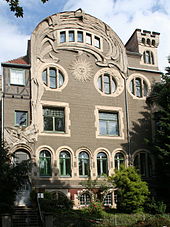
Art Nouveau buildings
Coburg is one of the places in Germany with a significant number of Art Nouveau buildings . These include, in particular, the sun house built by master builder Carl Otto Leheis in 1902, the Heiligkreuz elementary school on Schleifanger, the former M. Conitzer & Sons department store in Spitalgasse, the Ernst-Alexandrinen-Volksbad and the bank building of the former Creditkasse des Spar- und Hülfevereins in Steinweg (today a branch of the Unicredit Bank ) by Max Böhme from 1906 to 1912, the Eichmüller house in Judengasse by Paul Schaarschmidt from 1903 and the residential and commercial building in Bahnhofstrasse 10/12 by August Berger from the Year 1910.
Parks
The court garden between Schlossplatz and Festungsberg was laid out in 1680 by Duke Albrecht as a large manor garden in the Dutch style. It was given its present form as an English landscape park with a large number of native and rare tree species when it was expanded to the Veste in 1857 under Duke Ernst II. The cemetery on Glockenberg is also designed in the style of a landscape garden, with the Jewish cemetery on the eastern edge. There is a memorial stone under the heading "Victims of Fascism 1941–1945" lists the names of 48 Coburg Jews. (However, the list is incomplete.)
The lower facility, a green area with the abandoned Salvatorfriedhof, which was created when the eastern moats were leveled at the beginning of the 18th century, connects the courtyard garden with the rose garden at the congress house. The rose garden goes back to the Zollbauernwiese outside the city. The German Rose Show was held on this site in 1929 with almost 200,000 visitors. The garden, which was remodeled in the late 1980s, has around 70 different varieties of roses and aviaries for exotic birds. The flood fountain by the Coburg artist Ferdinand Lepcke is also set up in the rose garden .
Other small facilities are the Josiasanlage at the Bürglaßschlösschen, the Schnürsgarten at the Adamiberg and a path along the Itz. In the outer districts, the Rückert Park in the Neuses district, the park of the Ketschendorfer Castle and the Hans-Blümlein-Anlage in the Lehengraben (Creidlitz district) are particularly worth mentioning.
The Green Laboratory has been located on Himmelsacker, a western hill of the city, since 2000 . It was initiated by the former city councilor Horst Schunk, planned by Karl-Heinz Walzer from ISA Austria in Vienna and laid out by ISA Germany / Austria. The project researches trees for urban areas. This includes the first Coburg "Wedding Forest"; a second was created in Coburg-Neuses. To the south of the wastewater treatment plant on the Itz, an "alluvial forest" was also created, which is considered to be of great ecological importance.
Museums
Art collections of the Veste Coburg
The most important museum in Coburg is the art collections of the Veste Coburg , which emerged from the collections of the Coburg dukes. Arts and crafts from nine centuries can be viewed there. Among other things, 26 paintings by Lucas Cranach the Elder are on display. There is also a copper engraving cabinet , a collection of armor, weapons of war and hunting weapons as well as a glass collection.
Natural History Museum
The Natural History Museum goes back to the Ducal Art and Natural History Cabinet founded in 1844 and was given its current domicile in the Hofgarten in 1914. Among other things, exhibits on the topics of mineralogy , geology , palaeontology , archeology , ethnology and evolution are on display over an area of 4800 m² .
Visual arts
Since 1950, temporary exhibitions of contemporary art have been held in the pavilion of the Kunstverein Coburg am Hofgarten. The art association is a non-profit and registered association that is dedicated to the mediation of contemporary art and sees it as a forum for young artists. It was created in 1981 from the merger of the Coburg Art and Trade Association, founded in 1824, and the Coburg Art Association. The association is one of the oldest art associations in Germany and, with around 1700 members, is the largest art association in Bavaria.
Other museums
Also worth mentioning are the dolls museum near the Ehrenburg with its 4600 objects, the Friedrich Rückert museum in the Neuses district and the Kirchhof excavation museum, which is located next to St. Moriz under the office building and since 1994 excavations of a former Benedictine provost house from the 13th century showing ceramic objects.
The Callenberg Castle in the Beiersdorf district has been showing the Ducal Art Collection of furniture, paintings, porcelain and handicrafts from four centuries since 1998 . A watch cabinet can also be viewed. The German Rifle Museum has been located there since 2004 .
Aquarium
The privately operated Sea Star Aquarium was located in the Coburg district of Neuses . The aquarium existed since 2001 and was originally a quarantine and breeding station for various fish species such as sharks and rays. In 2002 it was opened to the public as the Sea Star Aquarium . Over 650 different animal species lived in more than 50 aquariums from 30 to 130,000 liters on 1000 m² of exhibition space. In September 2011 the aquarium was closed.
Sports
In addition to football , which is offered in 16 clubs and was represented by DVV Coburg in the regional league from 2007 to 2011, shooting has traditionally played a particularly important role in Coburg. There are four clubs here. The Schützengesellschaft Coburg 1354 is represented with an air rifle team in the 1st Bundesliga and won the German championship in 2008, 2009 and 2015.
One of the more unusual sports is the guard dance , which the Tanzsportgarde Coburger Mohr e. V. has been successfully representing throughout Germany for many years. After four German championship titles and many Upper Franconian, Franconian and South German championship titles, the Tanzsportgarde organized the South German Championships in 2006, but not in Coburg but in Bayreuth because of the too small Angersporthalle .
HSC 2000 Coburg , whose 1st men's team played in the handball Bundesliga in the 2016/17 season , also has many fans . The first men's team of the volleyball association VSG Coburg / Grub 2011 increased in the second German Volleyball Bundesliga and reached 2013 in the German Bundesliga Volleyball . In 2016 the relegation and bankruptcy of the club followed. The basketball club BBC Coburg managed to move up from the district league to the ProB , the third highest national league, within six years by 2017 . Also orienteering wins in Coburg increasingly important; In 2005, for the first time, a German team championship and a national ranking list run were held in Coburg.
The largest club in Coburg is the Coburg section of the German Alpine Club with around 3,300 members.
Regular events
The largest samba festival outside of Brazil takes place in Coburg every year , and has been attracting around 200,000 visitors over three days every July since 1992. Over 80 samba groups with more than 2,200 sambistas from eight nations performed, for example, from July 7th to 9th, 2006 on nine stages in the city center .
In August, the “Open Air Summer” sponsored by HUK-COBURG takes place annually on Schlossplatz with several concerts of various musical styles, groups and soloists. In 2007 the pop-rock singer Pink and the reggae / dancehall / hip-hop group Seeed performed . The opera The Magic Flute was also performed.
Coburg is the venue for the Coburg Whitsun Congress of the Coburg Convent (CC), an association of gymnastics and country teams, which organizes its congress with conferences, festivities , torchlight procession and sporting events every year at Whitsun .
Classical concerts are held several times a year in the St. Moriz Church by the Coburg Bach Choir.
In mid-July, the Schlossplatzfest, which calls itself the “Biggest Gourmet Party in Northern Bavaria”, is celebrated between Ehrenburg and Landestheater.
The spring festival takes place on the open space in Anger in spring and the bird shooting (shooting festival) takes place in early August. This is from the Schützengesellschaft Coburg 1354 e. V. organizes and attracts many visitors.
In addition to the Christmas market in December, there are other traditional markets. The Coburg flea market, which covers the entire inner city area twice a year, lasts from Saturday evening to Sunday. The Coburg Dumpling Market was held for the first time in 2006.
The "German Johann Strauss Days" (until 2009 "Johann Strauss Music Days") take place every three years . This is to commemorate the waltz king, who became a Coburg citizen in 1887 (and remained so until his death). These days were last held in September 2015. The “ Alexander Girardi International Singing Competition ”, which was part of the Johann Strauss Music Days until 2009, will no longer take place because the (financial) support from the city administration has been discontinued.
Since 2002 the “Zeitreise”, one of the largest German “Living History” events, has been taking place at the Veste in July in cooperation with the art collections. More than 100 performers show thematically excerpts from the life of bygone times with historical accuracy and thus complement the “exhibit” Veste and the exhibits in the art collections and fill them with life.
The Coburg Design Days have been held in May since 1989 .
Since 2003 the Motor-Sport-Club Coburg e. V. MSC holds a large young and old-timer meeting for vehicles and motorcycles on Schlossplatz every year at the beginning of May . Participants from all over southern Germany and Thuringia regularly come to these meetings, and occasionally also from northern Germany and other European countries.
Culinary specialties
- The best-known specialty from Coburg is the Coburg Bratwurst , the Coburg "national dish". It consists of pork and beef and does not contain marjoram, but up to five percent egg. A special feature is the type of grilling, for which neither wood nor charcoal , but well-dried pine cones , also known as “cool” in Coburg, are used. The length of the bratwurst should be 30 to 32 centimeters, corresponding to the length of the marshal's baton, which the figure of the city saint Mauritius is holding on the gable of the town hall. There is a bratwurst stand open all year round on the market square.
- The "Coburger Schmatzen" are made by the Bavarian gingerbread and pastry manufacturer Wilhelm Feyler. They are made from honey dough and contain nuts, almonds, orange peel, lemon peel and spices. After baking, the “Coburger Goldschmatzen” are also given a fine chocolate coating and a touch of gold leaf. The cookies were previously distributed to the Coburg elementary school students on St. Gregory's Day, which was last celebrated on July 13, 1971 in Coburg.
- Another specialty are the Coburg dumplings , also popularly known as "sliders". Half of these are potato dumplings made from raw (like the Thuringian) and half cooked (like the Franconian); occasionally the mixing ratio is 1/3 raw to 2/3 cooked. Inside, each dumpling should contain roasted white bread cubes ("Bröckla").
- The "Hof-Liqueur" is made in the court pharmacy according to a secret recipe.
- The "Coburger Rolle" is a soft cheese in different flavors.
Economy and Infrastructure
overview
In the past, Coburg was robust against economic fluctuations in the surrounding area. Although the city was disadvantaged for decades due to its peripheral location during the division of Germany, it is now one of the major economic centers of Northern Bavaria . The city owes this primarily to its mix of different company sizes from a wide variety of industries . Coburg heard - especially due to the high business tax payments of the insurance group HUK-Coburg - in terms of revenue from commercial, basic and income tax per capita of the richest municipalities in Germany. In 2017, the municipal tax force was 2919 euros per inhabitant, the highest value of all urban districts nationwide. In the overall ranking of all 397 independent cities and districts in Germany, the city of Coburg was in second place. Only the district of Munich had a higher tax rate per inhabitant.
The total debt of the city of Coburg at the end of 2012 was 59.7 million euros. That's 1458 euros per inhabitant. Of the 103 independent cities in Germany, Coburg had the third lowest per capita debt at this time.
In 2016, Coburg generated a gross domestic product (GDP) of 3.437 billion euros within the city limits . In the same year, GDP per capita was 83,501 euros (Bavaria: 44,215 euros, Germany 38,180 euros) and thus well above the regional and national average. Coburg thus had the sixth highest GDP per capita among the independent cities in Germany (behind Wolfsburg , Ingolstadt , Schweinfurt , Erlangen and Frankfurt am Main ). In 2016 around 42,600 people were employed in the city. The unemployment rate was 5.0% in December 2018.
In the Future Atlas 2016, the city of Coburg was ranked 23rd out of 402 rural districts and independent cities in Germany, making it one of the places with "very high future prospects". In the 2019 edition, it was ranked 106th out of 401.
Statistical data of the economy
On June 30, 2014, 33,369 employees subject to social insurance were employed in Coburg . Around 49% of the workforce is employed in the service sector , 34% in manufacturing and 16% in trade and transport. Around 20,000 people commute to work in the city every day, which explains the relatively high unemployment rate in relation to the Bavarian national average. Around 3,000 jobs are available in the authorities and public institutions.
Established businesses
The best-known company and largest employer in Coburg is the HUK-Coburg insurance group . Those of the resident in the city since 1950 insurance over 5700 local employees are mainly an administrative building in the city center at the train station and a major on the Bertelsdorfer height at junction Coburg A 73 distributed.
In addition, the manufacturing industry with the largest companies listed below is the most important pillar of the economy in Coburg. The family business Brose has been producing in the city since 1919 and is headquartered in Coburg. It is a major supplier to the automotive industry and has around 3,600 employees on site, who work in two plants in the south of the city. The company employs over 26,000 people worldwide.
The Kaeser Compressors SE, founded in 1919 by Carl Kaeser in Coburg, one of the leading suppliers of compressors and products of compressed air technology . Of the total of almost 6,000 employees, over 1,600 work in the Bertelsdorf district.
The Sagasser Vertriebs GmbH is one of the largest beverage markets in the area of northern Bavaria and southern Thuringia and has its headquarters in Coburg.
Machine tool construction is strongly represented in Coburg with the companies Waldrich Coburg , Kapp and Lasco . In the large machine tool industry, Waldrich Coburg is a manufacturer of precision machining centers and machines, has around 800 employees and was founded in 1920 by Adolf Waldrich. His son-in-law Bernhard Kapp laid the foundation stone for his own company in 1953, which today produces grinding machines for soft and hard fine machining of gears and profiles in Coburg with around 500 employees. Lasco was founded as an iron foundry and machine factory in 1863 and, with 340 employees, manufactures production systems for forming tasks .
Another focus is the plastics processing industry with the companies Gaudlitz, Hermann Koch and Ros. Gaudlitz was founded in 1937 and today, with around 260 employees (as of 2019), produces high-precision molded parts made from thermoset and thermoplastic raw materials. The Hermann Koch company has been in Coburg since 1914. Plastic packaging is developed and manufactured with 280 employees. The Ros company, founded in 1926, now has around 180 employees in Coburg in mold construction and injection molding and has specialized in complex components for the automotive and electrical industries.
The rare craft of picture stickers has also been represented in the city for over 150 years. The Thuringian flag factory , which was founded by Christian Heinrich Arnold in 1857, is one of the oldest flag factories in Europe. The family company still produces "hand-embroidered" club flags in Coburg.
Among other things, the Coburg Clinic , which was founded in 1862 and was relocated to its current location in the Ketschendorf district in 1903, is publicly owned . It is a center of care ( supply level III) and has 522 beds with a total of around 1,800 employees. The Sparkasse Coburg - Lichtenfels with around 700 employees in the region has its roots in Coburg in the Stadtsparkasse opened in 1822. The sole property of the city is the Städtische Werke Überlandwerke Coburg with around 350 employees, which, among other things, emerged from the gas works that opened in 1854.
Commercial area Lauterer Höhe
Years of disputes, discussions and two referendums revolved around a developed industrial area located in the north of the city on the federal motorway 73 , the area of which was partially incorporated from Lautertal . The city planned a 48,000 m² shopping and leisure center there in the late 1990s. In the project drafts of various investors, specialty stores and catering facilities, a fun pool, an artificial park with a lake, a small amusement park and a multifunctional and ice rink for around 6,000 visitors were planned.
Many business people in the city center feared that buyers would move to the outskirts. Therefore, it came in 2000 to the referendum , it was decided in the by a narrow majority of 27 votes against the development plan. In the following years, the development of the site was redesigned, including a new multifunctional hall. From 2005, the establishment of various food and specialty stores followed; Various service providers and catering establishments also set up shop. Shopping and specialist markets without a range of products relevant to the city center with 14,000 m² of sales area had been approved. On October 23, 2008 the city council decided to build a ball sports hall, today's HUK-Coburg arena on the Lauterer Höhe. The hall for a total of 3530 spectators was opened in August 2011. Around 25 facilities had been completed by 2018.
New inner city concept (NIK)
In autumn 2006 the entrepreneur Michael Stoschek and other Coburg businessmen presented the new inner city concept that they had developed themselves . The main aim was to make Coburg more attractive as a conference venue. To this end, the planned multifunctional hall is to be built on the Schützenanger, which is close to the city center, instead of on the Lauterer Höhe, as well as a conference hotel and the existing Rosengarten congress center expanded. The green has been used as a parking lot and fairground and is built on with a triple gym and sports facilities. According to NIK, these sports facilities are to be relocated to the north of the city. Critics of the concept cited, among other things, higher noise pollution, more traffic, an arena that did not fit into the historic cityscape and the large distance between the new sports facilities and the schools as the main arguments. In December 2006, in order to implement the NIK, the city council wanted the citizens to decide on the location of the multifunctional hall by means of a council request. At the same time, the NIK initiators launched a referendum with the same content, whereupon the council petition was withdrawn. A few weeks before the referendum in April 2007, the mayor Norbert Kastner and the Coburg SPD presented their own plans called the AHA concept (AHA = Arena + Halle am Anger). In this concept it was planned to build the multifunctional hall on the Lauterer Höhe, but at the same time to build a new triple gymnasium with a smaller culture and congress hall and hotel on the Schützenanger. Most of the sports facilities would have remained on the Anger. With around 52 percent of the votes, the citizens voted for the Schützenanger as the location of the multifunctional hall. While the NIK initiators said that by saying yes , the citizens also expressed their will to implement the remaining NIK plans, the city council now had to decide which measures should be carried out. The first step was in October 2007 the invitation to tender for an urban development competition in Coburg's New South, the result of which was presented at the end of April 2008. The next step should be a realization competition. On June 25, 2009, the city council finally decided on a new basic concept, since after the construction of a ball sports hall on the Lauterer Höhe, a multifunctional hall on the Anger is no longer required. The first step in the concept was to build a new triple gym at the corner of Bamberger Strasse and Karchestrasse, which was opened in 2017. After the old hall has been torn down, a town hall and a hotel will be built. The urban redesign of the Ketschenvorstadt (redevelopment area VI) is one of the larger inner-city construction measures.
traffic

Transportation
Local public transport in Coburg is operated by the Verkehrsgemeinschaft Coburg (VGC), a merger of SÜC Bus and Aquaria GmbH (SÜC) and Omnibusverkehr Franken GmbH (OVF). In 2010 there were nine city bus routes in the city with a total length of around 100 km, which are served by 40 buses every half hour during the day. The surrounding area is opened up with eleven lines, which usually run to the Coburg train station .
- Bus rendezvous Theaterplatz and ZOB Coburg
- The central transfer stop has been Theaterplatz since December 2007 . The rendezvous stop , which has also received a dynamic passenger information system , is designed for eleven buses and is only served by SÜC lines. In autumn 2009, after a two-year construction period, the central bus station (ZOB) was opened at the station with twelve stopping places and three waiting places. The buses of Omnibusverkehr Franken GmbH , OVG Sonneberg and SÜC stop there .
Rail transport
In the past, rail transport was more important. From 1858 to 1945 there was a continuous east-west connection across the Thuringian border with the Werra Railway from Coburg via Meiningen to Eisenach with 15 train connections per day in 1939. In 1892 a branch line to Bad Rodach was opened. In addition, there was a branch line to Rossach from 1900 to 1984 with the Itzgrundbahn and from 1901 to 1945 the continuous Steinachtalbahn via Ebersdorf - Sonnefeld - Fürth am Berg (until 1975) to Neustadt bei Coburg .
Regional express trains operate on the section of the Werra Railway to Lichtenfels and travel via Bamberg to Nuremberg . The route is served every two hours by the Franken-Thüringen-Express and every hour by the private railway Agilis . The route to Sonneberg, which was reopened in 1991, runs the Franken-Thuringia Express every hour . In addition, Agilis runs to Bad Rodach every hour.
There is a connection to the new Nuremberg – Erfurt line via a connecting curve . Since December 2019, a total of four pairs of ICE trains on the Berlin – Munich line have been stopping in Coburg from Monday to Friday - morning, afternoon and evening . At the weekend there are sometimes no morning trains. The closest ICE system stop is in Bamberg.
Road traffic
The city center is largely a pedestrian zone . For inner-city traffic there are the municipal car parks Mauer, Post, Albertsplatz and Zinkenwehr close to the center as well as, if no events take place there, the large Anger car park and some smaller parking spaces. There are hardly any bike paths in Coburg.
Long-distance road traffic is characterized by federal highways 4 , which as a north-south axis connects the Nuremberg area with Thuringia, and 303 , which connects Schweinfurt with the Czech Republic as a west-east axis , as well as the federal motorway 73 . While the B 4 crosses the city, the B 303 only affects the city center. Due to the border location, this was sufficient until 1990 as there was hardly any through traffic.
It was not until German reunification that Coburg had a motorway connection. As part of the German Unity transport project , it was decided to extend the federal motorway 73 Nuremberg - Bamberg via Lichtenfels and Coburg to Suhl . The new route forms the eastern branch of the Thuringian Forest Autobahn 71 and has been continuously passable since September 5, 2008.
air traffic
The Coburg-Brandensteinsebene airfield ( ICAO code: EDQC) was opened as a Coburg air base in 1913. It is owned by the city. The Aero Club Coburg e. V.
In the south of Coburg Furthermore, there's the special airfield Coburg-Steinrücken (ICAO EDQY). It has a grass runway with a length of 700 m and a load capacity of up to two tons. The owner and operator of the airfield on the Steinrücke is the Flugtechnische Arbeitsgemeinschaft Coburg e. V.
The nearest international airports are in Nuremberg in the south and Erfurt in the north, each approx. 90 km from Coburg.
Institutions and bodies
In addition to the municipal authorities, there are the following institutions and bodies:
- The Coburg State Foundation administers the ducal cultural assets that the Free State of Coburg received in 1919 through the severance agreement with Duke Carl Eduard. These are the fortress with the art collections and the natural history museum. Since 1941, the foundation has also acted as a branch of the Bavarian Administration of State Palaces, Gardens and Lakes.
- The establishment of a regional court was promised to Coburg when it was united with Bavaria. It opened on April 1, 1921. The associated judicial district included the Coburg district court districts of Coburg, Neustadt, Rodach and Sonnefeld and the Bavarian Kronach and Lichtenfels . In 2020, the district court district includes the districts of the district courts of Coburg, Kronach and Lichtenfels with a total of around 280,000 inhabitants. The district court was housed in the building of the ducal state ministry, with the meeting room of the Coburg state parliament, at the Ketschentor. This was destroyed in 1945 and inaugurated as a new judicial building in 1957.
- The Coburg District Court has been the central dunning court for all automated judicial dunning procedures in Bavaria since 2000 .
- In addition, the Forest and Domain Office, the Office for Food, Agriculture and Forestry , the Trade Inspectorate , the Chamber of Crafts and the Chamber of Commerce and Industry should be mentioned . The Coburg Chamber of Commerce and Industry is only responsible for the city and the district of Coburg and thus the smallest in Germany. These institutions still exist mainly because of the commitment made by Bavaria in 1920.
- The district office of the district of Coburg is located in the city.
- The German Johann Strauss Society has its headquarters in Coburg.
- The car registration is carried out together with the Coburg in Zweckverband Admissions Coburg .
Fire and rescue services
fire Department
The voluntary fire brigade of the city of Coburg comprises three fire engines that are stationed in the city center, in Ketschendorf and in Wüstenahorn. There are also district police in Bertelsdorf, Creidlitz and Löbelstein.
Ambulance service
The preclinical emergency medical care in the city is mainly provided by the Bavarian Red Cross . A total of seven rescue vehicles are stationed at the Coburg Nord ambulance in the city center, Coburg Süd in Schorkendorf and the ambulance in Bad Rodach . In cases of peak coverage, both a Rapid Response Group (SEG) from the BRK-Readiness Coburg and an SEG from the ASB are available.
The integrated control center (ILS) responsible for the fire brigade and rescue service is in Ebersdorf near Coburg .
Educational institutions
Libraries and Archives
The Coburg State Library was founded in 1919 as the successor to the Court and State Library of the Duchy of Saxony-Coburg, which had existed since 1547, and is housed in Ehrenburg Castle. It is a scientific regional library with over 400,000 volumes, of which around 85,000 volumes belong to the old stock from the 17th to 19th centuries. The city library in Herrngasse emerged from the public library of the Coburg Art and Trade Association from 1874.
In the state archive in the armory there are over 300,000 archive units on Coburg and the district as well as the Free State of Bavaria, the Duchy of Saxony-Coburg and its predecessors. In the city archive in Steingasse, 18,000 file units go back to the 13th century.
Colleges
The Coburg University of Applied Sciences was founded in its current form in 1971. It traces its tradition back to the crafts school founded in Coburg in 1814 by the ducal-Saxon architect Friedrich Streib. At the end of the 1950s, the then engineering school for civil engineering was expanded to include the two new departments of mechanical engineering and electrical engineering to form a polytechnic. Today's range of subjects is very varied and includes the four areas of technology, building / design / design, economics and social affairs. In 2018, around 5500 students were enrolled at the university. The main campus is located above the city on a mountain opposite the Veste Coburg. There is also another campus at the former Hofbrauhaus, which is home to the design faculty.
The first student union in Coburg was founded in 1894 with the Technical Association, which later renamed itself to Landsmannschaft in CC Franco-Borussia zu Coburg . It was followed by the Coburgia Technical Association, the Old Brno Burschenschaft Suevia, the Thuringia Catholic Student Association and the Hildburgia Engineer Association.
The Hohenfels University of Applied Sciences was a state-recognized private university for specialist therapies in health care. It was founded in 2004 by the Coburg Clinic and the Medau School, supported by the Coburg University of Applied Sciences. Starting in 2005, it was possible to study the bachelor's degree courses in physiotherapy and speech therapy at the university . In 2010 the university relocated to Bamberg and was renamed Bamberg University of Applied Sciences - Private University for Health .
schools
In Coburg there are 25 public and 16 private schools for around 11,000 students. The city describes itself as a school city. There are four grammar schools for the city and the surrounding area, in the city center the Albertinum , a music and linguistic grammar school, and the Casimirianum , a linguistic, humanistic and scientific-technological grammar school with 400 years of tradition. The other two schools are located on the Glockenberg, the Alexandrinum , a scientific-technological, linguistic, economic and social science high school, and the Ernestinum (founded in 1848), a mathematical-scientific, economic and European high school.
In addition to the Regiomontanus School, a state technical college and vocational college , the city has two vocational schools, thirteen vocational schools (for business, home economics , child care, nursing and child care), an agricultural school and a business school. The two state secondary schools Coburg I and Coburg II as well as twelve elementary and secondary schools complete the range of state schools.
Private schools are the Medau School, a technical school for gymnastics, physiotherapy and speech therapy , the Rudolf Steiner School, a Waldorf School , as well as the ASCO Language School Coburg (state-recognized vocational school for foreign language professions) and the Music School Coburg eV City and the district have a community college . The lessons at the singing and music school in the district of Coburg were discontinued due to insufficient financial means. Another private school is the Coburg Heilpraktikerschule in the Creidlitz district.
garrison
From the middle of the 19th to the end of the 20th century, Coburg was a garrison town for troops from the Duchy of Saxe-Coburg and Gotha and the Prussian Army , Wehrmacht , US Army and the Federal Border Guard .
Protected areas
In Coburg there is a nature reserve , three landscape protection areas , four FFH areas and two designated geotopes (as of March 2016).
See also:
- List of nature reserves in the city of Coburg
- List of landscape protection areas in Coburg
- List of FFH areas in the city of Coburg
- List of geotopes in Coburg
Personalities
One of the personalities associated with Coburg is Martin Luther , who stayed at the fortress for six months in 1530 because he was unable to attend the Reichstag in Augsburg because of the eight imposed on him .
Furthermore, the poet, translator and orientalist Friedrich Rückert is particularly worth mentioning, who lived in the Coburg district of Neuses from 1848 until his death in 1866 and found his final resting place there. In his honor, the city of Coburg launched the Coburg Rückert Prize , which has been awarded since 2008. The band master and composer Johann Strauss (son) , who became a citizen of Coburg in 1887, is also closely associated with the city's name.
Namesake of Coburg
- Other places: Coburg is also the name of numerous places in the " New World " that were mostly founded by emigrants from the region. These are the Canadian city of Cobourg , a suburb of the Australian city of Melbourne ( Coburg (Victoria) ) and American villages in Indiana , Iowa , Kentucky and Oregon .
- Coburg Island: Coburg Island is located in Baffin Bay in the Nunavut Territory in northern Canada ; it was named after the German Prince Leopold von Sachsen-Coburg , who was married to Princess Charlotte , daughter of King George IV of Great Britain.
- Ship Coburg: Various ships sailed under the name "Coburg". Among other things, it was a mail steamer belonging to the North German Lloyd , which had its maiden voyage in 1910 and was confiscated by the Brazilian government in 1917. From 1938 a motor ship from North German Lloyd and a fishing trawler from Geestemünde were called “Coburg”. The trawler was used for weather observation during World War II and was lost in the pack ice in 1944 . The motor ship sank in the Indian Ocean in 1941. From 1953 a motor ship (ex MS “Hamburg”) of Hapag , the first post-war new building , bore the city's name. Under the name “Coburg”, a supply ship (A1412) of the Lüneburg class , also known as the supply ship , drove with the German Navy from 1968 to 1991 . In 2005 a cargo ship of Universal Africa Lines was christened “UAL Coburg” and in 2007 a container ship from shipping company Leonhardt & Blumberg was christened “Hansa Coburg”. In addition, a barge registered in Klingenberg am Main has been sailing under the name Coburg since 2011 .
- Airplane Coburg: In 1968 and 1981 Coburg became the sponsor town of a Boeing 737 of Lufthansa. An Airbus A321-131 has been flying with Lufthansa under the registration number D-AIRD since 1994 and was christened “Coburg”.
- Railcar Coburg: A class 411 (1115) multiple unit of the Deutsche Bahn has been named after the city since 2003.
- Coburg March: The composer Johann Michael Haydn dedicated a presentation march to Prince Friedrich Josias of Saxony-Coburg-Saalfeld , which is now known as the Coburg March . It is part of the army march collection of the Bundeswehr (AM I, 26) and since 1986 battalion march of the tank battalion 344.
- Transmitter Coburg: Until around 1990 there was a transmitter for the DECCA radio navigation system near Coburg on Lauterberg, which belongs to the municipality of Lautertal . The Coburg-Eckardtsberg transmitter of Bayerischer Rundfunk is located in the city .
- Coburger Hütte: The Coburg hut of the Coburg section of the German Alpine Club in the Mieminger chain in Tyrol was opened in 1901. The valley is Ehrwald .
- 2003 rampage: On July 2nd, 2003, a rampage took place in the Coburg II state secondary school, in which a 16-year-old student injured a 52-year-old teacher with a gun and killed himself.
literature
- Hubertus Habel: Small Coburg City History. Verlag Friedrich Pustet, Regensburg 2009, ISBN 978-3-7917-2170-5 .
- Peter Morsbach, Otto Titz: City of Coburg (= Bavarian State Office for Monument Preservation [Hrsg.]: Monuments in Bavaria . Volume IV.48 ). Karl M. Lipp Verlag, Munich 2006, ISBN 3-87490-590-X .
- Heinz Pellender: Chronicle of the city and the fortress Coburg of the lords and rulers of Coburg and the Coburg region. 7th edition. Fiedler-Verlag, Coburg 1989, ISBN 3-923434-08-1 .
- Renate Reuther: Villas in Coburg. Coburg 2011, ISBN 978-3-925431-31-9 .
- Harald Sandner : Coburg in the 20th century. The chronicle of the city of Coburg and the House of Saxe-Coburg and Gotha from January 1, 1900 to December 31, 1999 - from the "good old days" to the dawn of the 21st century. Against forgetting . Verlagsanstalt Neue Presse, Coburg 2000, ISBN 3-00-006732-9 .
- Horst Schunk: Beyond the day - living with trees. The history of tree protection in Coburg. Veste-Verlag-Roßteutscher, Coburg 2011, ISBN 978-3-925431-32-6 .
- Werner A. Widmann: This is Coburg. Seewald Verlag, Stuttgart 1983, ISBN 3-512-00663-9 .
- Hellmut Worch: Coburg: The Franconian Crown, City and Country. Jan Thorbecke Verlag, Sigmaringen 1977, ISBN 3-7995-1063-X .
Web links
- Link catalog on Coburg at curlie.org (formerly DMOZ )
- Literature on Coburg in the catalog of the German National Library
- Coburg: Official statistics of the LfStat
- Life in Coburg. Video report. Series under our skies from BR (as of: July 24, 2017)
- City administration
- Urban development in Coburg
Individual evidence
- ↑ "Data 2" sheet, Statistical Report A1200C 202041 Population of the municipalities, districts and administrative districts 1st quarter 2020 (population based on the 2011 census) ( help ).
- ↑ a b c d Harald Sandner: Coburg in the 20th century. The chronicle of the city of Coburg and the House of Saxe-Coburg and Gotha from January 1, 1900 to December 31, 1999 - from the "good old days" to the dawn of the 21st century. Against forgetting . Verlagsanstalt Neue Presse, Coburg 2000, ISBN 3-00-006732-9 .
- ↑ For the population figures as of January 1, 2011, see the Coburg economic area. Facts and figures. Edition 2011/2012. (PDF; 625 kB), Section 2.4.2 Population statistics for the districts of Coburg .
- ^ Coburg. In: Heinrich Gottfried Gengler: Regesten and documents on the constitutional and legal history of German cities in the Middle Ages. Erlangen 1863, p. 506 ( scan in Google book search).
- ^ Walter Schneier: Coburg in the mirror of history. From prehistoric times to the present. In the footsteps of princes, citizens and farmers. Druck- und Verlagsanstalt Neue Presse, Coburg 1985, DNB 860234649 , p. 59.
- ^ Wolfram Nagel: Coburg. Thanks to Luther to the Reformation city of Europe. In: Deutschlandfunk . February 2, 2015, accessed October 3, 2019.
- ↑ a b c City portrait of the project “Reformation Cities of Europe”: Reformation City of Coburg. Germany. In: reformation-cities.org/cities, accessed on October 9, 2019, cf. the city portrait of the project "European Station Path" : Coburg ( Memento from June 29, 2019 in the Internet Archive ). In: r2017.org/europaeischer-stationsweg, accessed on October 9, 2019. For information on the importance of Coburg in the history of the Reformation, see the sections History: 11th to 18th centuries and religion .
- ↑ Traudl Kleefeld: Against forgetting. Witch persecution in Franconia - places of remembrance. J. H. Röll, Dettelbach 2016, p. 26 ff.
- ↑ Walter Schneier: Coburg in the mirror of history, from prehistoric times to the present: on the trail of princes, citizens and farmers . Druck- und Verlagsanstalt Neue Presse GmbH, Coburg 1985, p. 277.
- ↑ Memorial Book. Search in the name directory. Search for: Coburg - residence. In: bundesarchiv.de, accessed on March 3, 2020.
- ^ German Association of Cities: Statistical yearbook of German municipalities. Braunschweig 1952, p. 384.
- ↑ Report on the 2015 financial year (PDF; 2.0 MB) HUK-COBURG Insurance Group, 2016, p. 43 , accessed on March 30, 2017 .
- ↑ asr: Trade tax increases: In which municipalities the cash register rings . In: Handelsblatt . October 24, 2012 ( handelsblatt.com [accessed March 11, 2018]).
- ↑ a b Wilhelm Volkert (Ed.): Handbook of the Bavarian offices, communities and courts 1799–1980 . CH Beck'sche Verlagsbuchhandlung, Munich 1983, ISBN 3-406-09669-7 , p. 601 .
- ^ Federal Statistical Office (ed.): Historical municipality directory for the Federal Republic of Germany. Name, border and key number changes in municipalities, counties and administrative districts from May 27, 1970 to December 31, 1982 . W. Kohlhammer, Stuttgart / Mainz 1983, ISBN 3-17-003263-1 , p. 670 .
-
↑ Koburg . In: Brockhaus Bilder-Conversations-Lexikon . 1st edition. Volume 2, FA Brockhaus, Leipzig 1837-1841, pp. 627-627 . - With mention of the "Feste Koburg". -
Spelling Sachsen-Koburg-Gotha in the Statistical Yearbook 1880 -
Koburg . In: Meyers Konversations-Lexikon . 4th edition. Volume 9, Verlag des Bibliographisches Institut, Leipzig / Vienna 1885–1892, p. 899. - ↑ Catholic Church Foundation St. Augustin: Festschrift for the 150th anniversary of the parish church St. Augustin in Coburg .
- ^ City of Coburg Religion. In: 2011 census . May 9, 2011, accessed March 2, 2020.
- ↑ a b Coburg info, data & facts. Denomination (as of December 31, 2019), accessed on March 2, 2020.
- ^ Coburger Tageblatt. November 12, 2009, Coburg City section , p. 9.
- ↑ Official population figures of the Bavarian State Office for Statistics and Data Processing
- ↑ Integrated urban development concept Coburg. Values and change. Edited by Walter Ackers on behalf of the City of Coburg, December 11, 2008, p. 16 ( Forecasts for 2020; PDF; 5.3 MB [March 30, 2009, changed on March 23, 2010, accessed on October 20, 2018] ).
- ↑ “Free voters” are no longer “Free voters”. In: New Press . Coburg, September 14, 2012.
- ^ Coburg City Council. New parliamentary group “Social and Citizens' Close for Coburg” ( Memento from April 2, 2015 in the Internet Archive ). In: Bayerischer Rundfunk . February 18, 2015, accessed March 2, 2020.
- ↑ CSU and JC form a joint parliamentary group in the Coburg city council. In: inFranken.de . March 6, 2015, accessed March 2, 2020.
- ↑ Result of the 2020 city council election on March 15, 2020. In: coburg-waehlt.de, accessed on April 5, 2020.
- ↑ Lord Mayor Dominik Sauerteig. City of Coburg, accessed on June 5, 2020 .
- ^ Entry on the Coburg coat of arms in the database of the House of Bavarian History , accessed on September 6, 2017 .
- ^ Entry on the Coburg coat of arms in the database of the House of Bavarian History , accessed on September 6, 2017 .
- ↑ The city arms - The Coburg Mohr. City of Coburg, accessed on December 6, 2013 .
- ^ Coburg enters into twinning with Toledo (Ohio). inFranken.de, August 8, 2019
- ↑ Old Catholic parish of St. Nikolaus Coburg & Brilliant Group GbR: History of the St. Nikolaus Chapel. (No longer available online.) In: sanktnikolauscoburg.de. Old Catholic parish of St. Nikolaus Coburg, 2005, archived from the original on December 8, 2011 ; accessed on October 20, 2018 .
- ↑ Helke Renner: The Sea Star closes. In: inFranken.de. August 16, 2011, accessed March 11, 2018 .
- ^ Nürnberger Nachrichten. July 16, 2007.
- ↑ Christian Boseckert: The Coburg bratwurst. In: Coburg, Edition Bavaria. Ed. Bavarian State Ministry for Science, Research and Art; House of Bavarian History. Augsburg 2013, ISBN 978-3-7917-2504-8 , p. 74.
- ↑ a b Bertelsmann Stiftung (ed.): Kommunaler Finanzreport 2019 . 2019, ZDB -ID 2834171-5 , p. 16, 22 , doi : 10.11586 / 2019045 , urn : nbn: de: hbz: 6: 2-96979 ( bertelsmann-stiftung.de [PDF; 8.0 MB ; accessed on October 14, 2019]).
- ↑ Debt ranking of the 103 independent cities in Germany. Household control.de, accessed on September 28, 2014 .
- ↑ Current results - VGR dL. Retrieved January 7, 2019 .
- ↑ State of Bavaria. Federal Employment Agency, accessed on January 7, 2019 .
- ↑ Future Atlas 2016. (No longer available online.) Archived from the original on October 2, 2017 ; accessed on March 23, 2018 .
- ↑ Future Atlas 2019 | Handelsblatt. Retrieved December 10, 2019 .
- ↑ Statistics communal 2015. (PDF; 1.2 MB) Kreisfrei StadtCoburg 09 463. (No longer available online.) In: statistik.bayern.de. Bavarian State Office for Statistics , July 31, 2016, p. 8 , archived from the original on November 7, 2017 ; accessed on March 29, 2019 .
- ↑ Integrated urban development concept Coburg. Values and change. Edited by Walter Ackers on behalf of the City of Coburg, December 11, 2008, p. 12 ( PDF; 5.3 MB [March 30, 2009, changed on March 23, 2010, accessed on October 23, 2018]).
- ↑ HUK-COBURG Insurance Group: Report on the 2017 financial year ( PDF; 1.5 MB [accessed on October 20, 2018]).
- ^ Coburger Tageblatt. December 24, 2014.
- ^ Declaration of love to Coburg. In: New Press Coburg. July 20, 2018, accessed October 20, 2018 (conditional access).
- ↑ The ball sports hall is called HUK-Coburg-Arena. Granting naming rights to insurers ( memento of July 15, 2011 in the Internet Archive ). In: radioeins.com. October 21, 2010, accessed December 20, 2016.
- ↑ New press. October 25, 2008.
- ↑ Coburg takes place inside ( Memento from May 29, 2007 in the web archive archive.today ). In: neueinnenstadtkonzept.de. May 29, 2007, accessed December 20, 2016.
- ↑ New press. April 26, 2008.
- ↑ (os): On your marks , Anger, go! (No longer available online.) In: Coburger Tageblatt. June 26, 2009, archived from the original on July 19, 2011 ; accessed on March 29, 2019 (import article).
- ↑ City of Coburg - HS Stadtbauamt - urban redesign of the Ketschenvorstadt (redevelopment area VI).
- ^ FF Coburg: Locations of the FF Coburg. Retrieved May 1, 2020 .
- ^ BRK KV Coburg: BRK rescue service in Coburg city and country. Retrieved May 1, 2020 .
- ^ BRK readiness Coburg: civil protection BRK Coburg. Retrieved May 1, 2020 .
- ↑ ASB Coburg is also involved in disaster control. Retrieved May 1, 2020 .
- ↑ About us. In: franco-borussia.de. Landsmannschaft in CC Franco-Borussia zu Coburg, accessed on March 29, 2019.
- ^ Coburger Tageblatt. 29./30. January 2011.
- ↑ Curious. Coburg, ahoy! In: franken.de. January 29, 2011, accessed October 3, 2019.
- ↑ Information on the website of the Freundeskreis der PzBtl 144-344 e. V. Accessed August 4, 2015.








